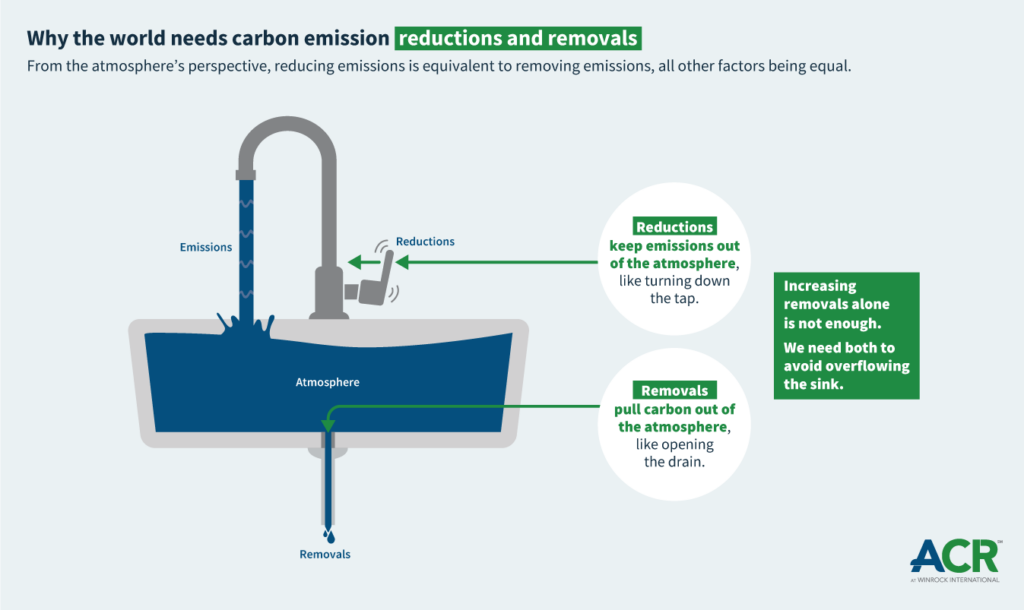
Carbon Markets 101: ACR series explores and explains carbon markets
ACR series shares insights into how the world’s first private voluntary GHG registry tackles complex issues in its mission to set the bar for carbon credit quality.
Increasingly extreme and unpredictable weather is impacting nearly all aspects of life on the planet. Marine heatwaves are killing coral reefs and forcing fish to flee to cooler waters — disrupting the entire food chain. Melting ice caps and rising seas are swamping coastal habitats, from salt marshes to mangrove forests that serve as critical fish nurseries and storm buffers for people. On land, rising temperatures and changes in precipitation patterns are creating drier conditions, exacerbating drought and increasing the risk of wildfires.
Reducing and removing carbon emissions can help mitigate these impacts, of course.
But if you have ever wondered why the world needs both carbon emission reductions and removals – and what the difference is between them − check out the latest installment of ACR’s Carbon Markets 101. The series taps technical experts from ACR – which was the world’s first private voluntary GHG registry when it was founded in 1996 − and uses easy-to-grasp illustrations to demystify carbon markets, explain key points, and highlight how markets contribute to protecting our planet from climate risks.
This infographic and narrative were originally published on acrcarbon.org.

Even as the world continues to release climate-changing gases into the atmosphere, there is a growing perception that carbon removals are more effective or preferable to emission reductions when it comes to carbon credits. This is a misconception, as both emission reductions and removals play a vital role in tackling climate change.
Understanding carbon emission reductions and removals
Think of carbon in the atmosphere like water in a sink. Reductions prevent emissions from entering the atmosphere—similar to turning down the tap to slow the flow of water. Removals extract carbon from the atmosphere—like opening the drain to let water out.
From the atmosphere’s perspective, emission reductions and removals are both vitally important. Removals alone won’t solve the problem. To prevent the “sink” from overflowing, we need both reductions and removals working together.
Why both carbon reductions and removals matter
The example of natural climate solutions
Protecting and restoring forests are among the most effective natural climate solutions. Forest conservation can reduce emissions. Reforestation can remove carbon from the atmosphere over time—as the new trees grow.
Recent research published in Nature Climate Change (2024) reinforces this point, finding that tropical and temperate forest conservation (reductions) and tropical and temperate reforestation (removals) have the highest potential for impact as natural climate solutions. In other words, both reductions and removals are essential.
Immediate action yields greater impact
The urgency to cut emissions now cannot be overstated. Deforestation and forest degradation contribute 12-20% of total global emissions, while methane leaks are responsible for one-third of global warming to date. Additionally, nearly half of all species are in decline due to habitat loss.
Reducing emissions now is more cost-effective than removing emissions from the atmosphere later. In addition, removals—whether through reforestation or emerging carbon capture technologies—take time to scale up and deliver results.
A balanced approach to climate action
Focusing only on carbon removals overlooks the urgent need to prevent emissions from entering the atmosphere in the first place. A well-rounded climate strategy incorporates both reductions and removals for long-term climate stability.
ACR advocates for a portfolio approach for credit buyers that integrates multiple solutions. Its methodologies support emission reductions and removals across various sectors, including forestry and wetlands (AFOLU), carbon capture and storage (CCS), industrial sources, and waste handling and disposal.
To help organizations and stakeholders better understand and communicate the critical role of both reductions and removals, ACR created an infographic that illustrates their importance.
We encourage you to download and use the infographic here; check out previous installments in ACR’s Carbon Markets 101 series here.
